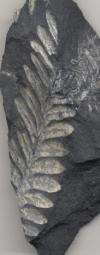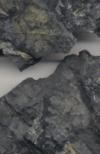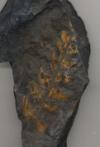Fern Fury!I had a friend from Maine come into town last weekend and this being his first time to the tri-states area we had to come up with something to do… Humm, history – nah; art museum – you kidding me!!! I know – fossil road trip!!!!
He arrived at 1:00 and we were on our way up I-95 and the New Jersey turnpike to the Cretaceous outcrops of marine fossils in the brooks of Monmouth County, New Jersey. After the short detour due to road construction (and a short stop for a sub sandwich – PA & NJ make the best subs hands down!!!) we were in the Ramanesson sifting through the sand and pebbles and finding sharks teeth. Clay was a natural, finding a shark tooth; Squalicorax sp. (crow shark) on his very first sift!! My find for the day was my first complete Ischyriza sp. (saw fish) tooth from the site. We only had a few hours of sunlight and by 4:30 we had to call it a day. All finds, about 40 teeth in all, were given to Clay so that we could assemble them for a classroom display. Sorry no pictures…
The next day we departed at 5:30AM for a trip into the Anthracite coal regions of Pennsylvania. Our first stop was at the world famous fossil fern locality of St. Clair in Schuylkill County, Pennsylvania. This locality produces abundant plates of fern fossils located in a wavy shale bed. The wavy nature makes the fossils extremely brittle and hard to extract. This site would be incredible if the shale broke in a clean slate-like pattern but that’s just not how it works. The ferns are preserved in amazing detail. The break down of the leaf matter is replaced by pyrite (from sulphides). Pyrophyllite (aluminum silicate, a whitish mineral) is believed to have replaced the pyrite at a later stage as the sediments piled up and the temperature and pressure became greater. This chalky white coating is what makes ferns from this site distinctive and obvious throughout the world as from St. Clair even to just the casual collector.
Occasionally bugs (beetles, spiders, mosquitoes, etc.) can be discovered mixed in with the ferns as well. This site is the namesake for the Pennsylvania period (325-286 mya), also known as "the coal age" in Paleozoic era geological history.
The site is about a 3/4 miles walk back into the woods and it served to warm us up, as it was the first day of the Fall season with a hard frost on the ground. A friend of mine took us to his favorite spot for these fossils and the area was just littered with them. It was the fossil equivalent of shooting fish in a barrel!!! In the course of under three hours we had numerous species and specimens ready to be wheel barrowed back to the truck. I have estimated that we found at least six different species of fern at the site The most commonly found ferns are Alethopteris, Neuropteris, and Pecopterisa and can be found stacked upon themselves in such abundance that it becomes impossible to distinguish them individually.
After about three hours at this site we had four five-gallon buckets crammed with pieces to be used as give ways.
|
Location
| Schuylkill County, Pennsylvania, USA |
| ID | 533 |
| Member | m4 |
| Date Added | 11/12/2005 |
 |
| Alethopteris |
|
 |
| Alethopteris |
|
 |
| Unknown. Any ideas? send me an email. |
|
 |
| Unknown. Any ideas? send me an email. |
|
|